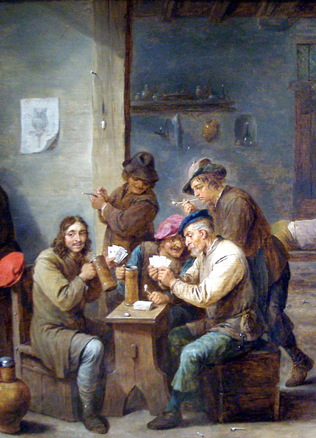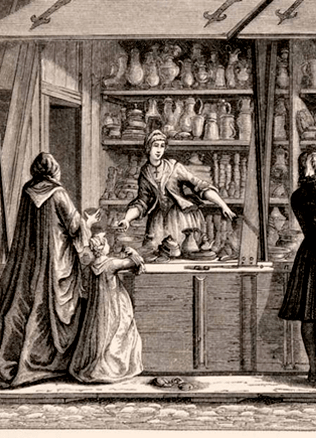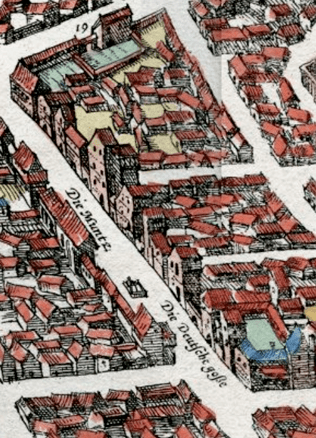Seized or bought? Commercial seals and “foreign” objects
The needs of the dukes and the nobility who established their positions in the 13th–14th century grew tremendously. Local production failed to satisfy the grand duke’s environment that required a show of prestige. Silk fabric, goblets made of coloured glass, wine brought in amphorae, various never-before seen objects, and exotic foods became a desirable commodity. On the other hand, like in earlier times, all jewellery of the Balts was made of imported non-ferrous metals and food was flavoured with salt, so these commodities have always been in demand.
Archaeological finds contain “foreign” objects, i.e. non-locally made ones, materials or raw materials, which most often are interpreted as witnesses of the early trade relations. On their bases it is sought to determine the direction of the former trade routes, the countries with which the Lithuanian merchants of that time as though traded. Do these “imported” objects really testify to peaceful sale and purchase transactions?
Marauding warriors and trading robbers
Lithuanian commercial travellers are seldom mentioned in historical sources of the 13th-14th centuries and not always in the positive.
Do You Know?
In the 13th–14th century exotic goods brought from foreign countries have also been discovered in the Duke’s environment. Perhaps we shall never be able to find out in what way the glass goblets inscribed with the Arabic characters from the Near East or glazed ceramics made by a potter from Kievan Rus’ reached the Duke’s table.
We learn from the complaint lodged by the residents of Riga (1286–1307) to the Duke of Vitebsk that a dweller of the town of Riga went to the Lithuanians near Vitebsk not to buy wax or furs but to purchase female slaves. The Archbishop of Riga John II in his letter (1287) to the Prefect of Lübeck, the magistrate and the townspeople mentioned the Lithuanian merchants who came to Riga to trade – people of Traidenis. They were arrested in seeking to liberate the messenger of the residents of Riga who had been taken prisoner in Lithuania. Traidenis, however, rejected this offer and stated that he did not care about the fate of the arrested merchants – “villagers” and “dogs”. We learn from other sources that King Mindaugas’ nephew Treniota also sent servants with some commodities but the Livonian brothers of the Order seized them. Hence, the historical sources reveal that the 13th century ethnic Lithuanian “merchants” are worn out by constant warfare and once a chance presented itself, they would trade in girls, or any other booty, or serve as messengers for the grand duke. On the other hand, pagan merchants were full-fledged players in the market and were already seen in trade contracts concluded later. The ten-year trade agreement concluded by the Master of the Order, Riga townspeople and Gediminas and his sons – the Dukes of Polotsk and Vitebsk and the dwellers of these towns, provide for the territories in which any military action was prohibited. The following is indicated: “Daugava has to be free for every merchant, no matter whether he is a Christian or a pagan (…) when a German merchant arrives in Lithuanian land or Russia, he can travel wherever he wants; equally a Russian or a Lithuanian merchant, when he arrives in Riga, he can travel in the land of Livonia”. The book of debts of Riga (1286–1352) writes that two merchants from Kernavė – Rameikis (1290) and Studilas (1303) ran into debt for several pounds of wax. Creditors hoped to recover the debt from the Lithuanian merchants, which is an indicator of the long-term trade relations. In the 14th century independent markets rather than the merchants’ estate governed by the Duke were already in existence in Lithuania.
Historical sources illustrate the routes thereby the majority of “imported” objects found their way to the cultural layers of Vilnius or Kernavė. According to the historian Artūras Dubonis, “marauding of Lithuanian soldiery in the eighties of the 12th century, long-term ambushes near the Dauguva River, robberies of the merchants’ strings of carts and the merchants themselves sooner seemed to be the daily routine than an exception.” In the 13th century the number of military marches organised by the Lithuanians, which in essence were marauding, seemed to be really large. The threats posed by Lithuanian soldiery to foreign merchants and financial losses incurred on them are mentioned in a number of agreements, complaints and letters of that time. To curb the situation, in 1367 the so-called “peace of marauders” was concluded between Algirdas, Kęstutis and the Master of Livonia. It established the lands of peace, which the “marauders” of both countries were banned to enter, with the exception of the Lithuanian and Livonian armies.
Exotic commodities and their routes to Lithuania
“Imported” goods discovered by archaeologists cannot be assessed unambiguously within the context of trade relations of the 13th–14th centuries vividly illustrated in historical sources. The route of each group of non-locally produced things or even the route of a separate article to ethnic Lithuania could have been different. A political, multi-confessional structure was characteristic of Vilnius, Kernavė, as it was of every medieval town.
“Imported” were the communities that tried to wear groups of certain jewellery rather than those groups of jewellery themselves.
Glass bracelets and crosses made in the town of Rus’ found in the part of the upper town of Kernavė are related to the community of the Orthodox believers, which was likely to be settled there. Styluses –writing utensils – found in the hillfort of Aukuras Hill in Kernavė, illustrate the “import” of intellect, that is, of a clerk rather than of trade. Craftsmen who produced, from our viewpoint, products of imported origin, could have been successfully “imported” to the Duke’s court. Lead seals of the commodities dated to the 14th century have been discovered in the territory of the Duke’s Palace of the Lower Castle of Vilnius and the residence of the Duke located in the hillfort of Aukuras Hill. Certain commodities were sealed seeking to ensure that they should reach the addressee without being damaged. It is thought that the seal found in Kernavė came from Venice, it was likely to have been attached to silk. Commercial seals show direct trade relations with the distant countries. However, when we remember sad stories of the merchants who travelled along the Daugava River we have different ideas. One of the most impressive “imported” articles is the bronze statuette of Perkūnas, the Lithuanian god of thunder, as elucidated later, a part of a church candlestick. It is difficult to imagine a warrior or a merchant of Traidenis’ time buying a church candlestick somewhere in Livonia. Perhaps we shall never be able to find out in what way the glass goblets inscribed with the Arabic characters from the Near East or glazed ceramics made by a potter from Kiev Rus’ reached the Duke’s table. Foreign objects could get into the Duke’s environment as gifts, ransoms, tributes or customs duties.
The questions “seized or bought” will never be answered.
The only direct archaeological finds demonstrating trade are scales and weights discovered in the graves of rich mainly Curonian soldiers. They are also found in the cultural layers of the towns of the Grand Duchy of Lithuania of the 13th–14th centuries. They can be successfully used to weigh salt too. It is difficult to say whether the scales discovered in the graves of the Curonians were attributes of a soldier or of a merchant. Perhaps, the Curonians took over the tactics of Scandinavian Viking soldiers-merchants, and later the Lithuanian warriors did that as well. It was only the means of communication that differed – the latter rode rather than sailed on a march.
Silver monetary alloys – the Lithuanian long ones related to the foreign systems of weight measurements are considered to be direct witnesses to the local and international trade transactions. Lithuanian alloys weighing about half the Scandinavian Mark (204 g) of a semicircular cross-section were used in trade until the end of the 14th century. However, there is no unanimous opinion about the time when these alloys were put into circulation. It is stated that this was possible only after the state with a strong centralised power of the Duke had been formed.
Gintautas Vėlius



